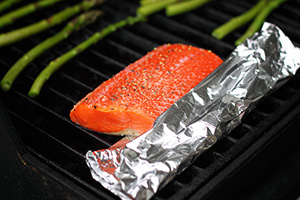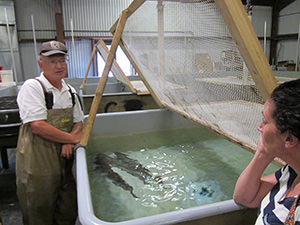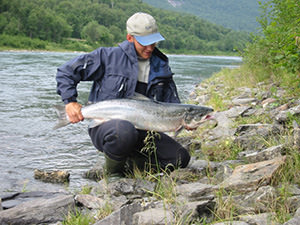
Farmed Salmon Is Healthier Than You Think
Posted on 21 Jul, 2019

While “wild” and “farmed” conjure up profoundly different images (one of happy salmon and the other of hormone-stuffed Frankenfish), the differences between the two aren’t as troubling as one might expect — at least, not in terms of health. We took a closer look at the salmon industry so you can finally decide which is worth your cash.
Which is Better When it Comes to Health?
 With a nutritional profile full of heart-healthy omega-3 fatty acids, salmon is one of the most popular fish among health-conscious folk, and about 70 percent of our supply is raised in farms (via “aquaculture”) to meet global demand. Between 1990 and 2010, the world’s total production of farmed salmon jumped from 299,000 tons per year to 1.9 million, an increase of over 600 percent. But is more farming a step in the right direction?
With a nutritional profile full of heart-healthy omega-3 fatty acids, salmon is one of the most popular fish among health-conscious folk, and about 70 percent of our supply is raised in farms (via “aquaculture”) to meet global demand. Between 1990 and 2010, the world’s total production of farmed salmon jumped from 299,000 tons per year to 1.9 million, an increase of over 600 percent. But is more farming a step in the right direction?
Because of the food they’re fed (mostly fishmeal, a processed mix of small fish like anchovies and sardines) and how little they’re able to exercise, farmed salmon contain about 35 percent more fat than their wild caught counterparts . This means farmed salmon contain more of those terrific omega-3 fatty acids, but, unfortunately, their fat is also great at storing environmental contaminants . Although wild salmon contains more mercury, the farmed variety tends to have concentrations several times higher of chemicals that have been linked to cancer, including various pesticides and polychlorinated biphenyls (PCBs), a common environmental pollutant.
[Related: The 9 Safest Seafood Options]
However, the amount of these substances in farmed salmon is still about sixty times lower than the level of concern for human consumption that has been established by both Health Canada and the FDA . For this reason, there’s a fairly popular belief that the benefits from the high fat content of farmed salmon outweigh the potential dangers of chemical contamination.

If toxicity is still a concern, it’s always a good idea to be prudent about where the farms themselves are located. Many experts seem to agree that salmon from Canada (particularly British Columbia) carry fewer chemicals than fish farmed in the U.S.. The very safest salmon are believed to be farmed in Chile, while Scottish and Norwegian varieties should be eaten as little as possible.
Fat content and toxicity aside, the USDA has a great online database where you can look at lists of the nutrients found in both farmed and wild Atlantic salmon. While they have roughly the same amount of protein, there’s 50 percent more potassium and nearly three times as much iron in wild salmon, while farmed is much higher in B vitamins, particularly thiamine and folate (and, of course, the omega-3 fats). As with many kinds of fish, however, pregnant and nursing women are cautioned to limit their intake of certain varieties — salmon’s inclusion on these lists is somewhat contested, so it’s best to read widely.
What About the Environment?
 While it provides some health benefits, fish farming can have some seriously harmful environmental impacts. Salmon are typically bred inside of densely-populated net-cages, which float in natural bodies of water and allow for all sorts of damage to the seabed and local sea life: They’re known to leach pesticides, viruses, antibiotics, and heavy metals like zinc and copper into their surrounding waters. Farmed salmon are also known to escape from farms and interbreed with native fish, damaging local gene pools and creating infertile spawn.
While it provides some health benefits, fish farming can have some seriously harmful environmental impacts. Salmon are typically bred inside of densely-populated net-cages, which float in natural bodies of water and allow for all sorts of damage to the seabed and local sea life: They’re known to leach pesticides, viruses, antibiotics, and heavy metals like zinc and copper into their surrounding waters. Farmed salmon are also known to escape from farms and interbreed with native fish, damaging local gene pools and creating infertile spawn.
However, the most serious risk involved with farming tightly-packed salmon might be the spread of sea lice. One study found that, typically, 80 percent of local salmon die from farm origin sea lice outbreaks, and incidences of 95 percent mortality are not unheard of . All of these factors contribute to farming’s negative environmental footprint: A study of farms in Scotland, Ireland, and Canada showed many cases of aquaculture reducing nearby salmon and other fish populations by more than 50 percent.
None of this to say wild salmon comes without a cost to the environment. The practice has already put a third of the planet’s wild salmon population at risk of extinction.
The solution to more sustainable aquaculture may lie in land-based closed containment farms, which eliminate many problems currently related to raising salmon . Unfortunately, they’re difficult to run at a profit, but the Canadian government and some private companies are hoping to prove otherwise — they’ll have a better idea after their first harvest in 2014.
The Takeaway
If the only consideration is health and price, there’s nothing wrong with enjoying farmed salmon, particularly if it hails from Chile or Western Canada. If the environment is more of a concern, the research seems to favor the wild variety.
 In any event, it’s important to remember that while salmon is a healthy food, it’s not a unique source of any nutrients. A serving of oily fish like herring and mackerel contains just as many omega-3s as salmon. If chemicals are of concern, oily fish that are lower on the food chain, such as sardines and anchovies, tend to harbor far fewer toxins. Any issues one might have with salmon’s risks can be mitigated with a varied diet — something that’s tremendously important both for one’s health and for the environment.
In any event, it’s important to remember that while salmon is a healthy food, it’s not a unique source of any nutrients. A serving of oily fish like herring and mackerel contains just as many omega-3s as salmon. If chemicals are of concern, oily fish that are lower on the food chain, such as sardines and anchovies, tend to harbor far fewer toxins. Any issues one might have with salmon’s risks can be mitigated with a varied diet — something that’s tremendously important both for one’s health and for the environment.
Source: http://greatist.com/health/farmed-wild-salmon-health-environment
Photo Credits
Great Books For Pescatarians

by Janis Jibrin

by Kathy Hunt

by Becky Selengut

by Mrs. Stephanie J Harris-Uyidi

 Caffeine Exposed - Interesting Facts About Caffeine You Never Knew
Caffeine Exposed - Interesting Facts About Caffeine You Never Knew The Best Foods For Stress Relief
The Best Foods For Stress Relief 7 Reasons to Consider a Pescatarian Diet
7 Reasons to Consider a Pescatarian Diet The 9 Safest Seafood Options
The 9 Safest Seafood Options










